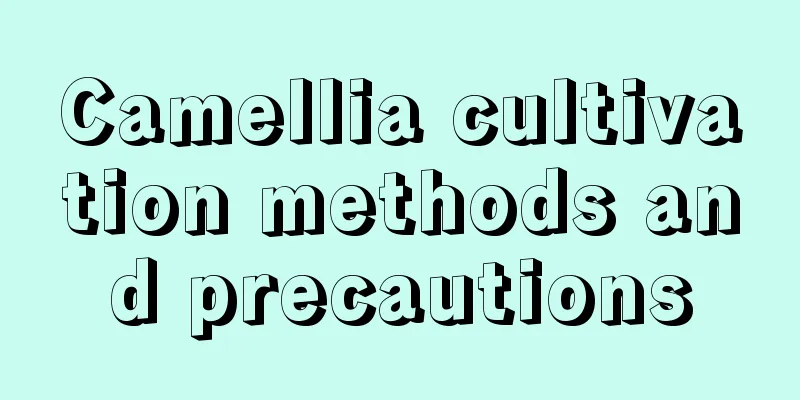Camellia cultivation methods and precautions

|
Camellia is deeply favored by flower lovers for its elegant tree shape, dark green leaves, evergreen characteristics, and bright flowers. However, if not properly maintained, camellia is prone to problems such as yellowing leaves and premature aging of flower buds. Let’s learn about the camellia cultivation methods and precautions below. 1. Pot soil selection Camellias prefer acidic, well-drained soil. It is recommended to use sandy soil, loess or humus soil, or a mixture of mountain mud, leaf mold and sand. If nutrient soil is used, it can be mixed evenly in the ratio of 1:2:1 among peat soil, leaf mold and garden soil and then planted. 2. Water properly When planting, make sure the camellia roots are in close contact with the soil. You can use a small wooden stick to gently poke around the roots to help the soil enter. The rooting water needs to be poured thoroughly and can be watered multiple times. Daily watering should be done after the surface of the potting soil is dry. Camellia is relatively drought-resistant and should not be watered excessively. 3. Fertilization during the growing season Camellia has a short vegetative growth period and spends most of its time forming buds. The vegetative growth period is from spring flowering to early summer. At this time, new shoots grow rapidly. You can apply balanced nitrogen, phosphorus and potassium fertilizers or spread controlled-release fertilizers along the edge of the pot. In summer, camellia begins to differentiate flower buds, and phosphorus and potassium fertilizers can be applied 2-3 times. It is recommended to stop fertilizing in midsummer, and apply phosphorus and potassium fertilizers again at the end of September in autumn, once every 15 days or so until flowering. 4. Lighting management Camellia likes light but cannot tolerate strong light. It can be exposed to full sunlight in spring, autumn and winter, but needs shade in summer to avoid direct sunlight to prevent sunburn on the leaves. 5. Thinning buds Camellias are often full of flower buds, but too many flower buds will lead to insufficient nutrients, and the buds will turn yellow before blooming. Bud thinning should be done when the flower buds grow to the size of soybeans, leaving 1-2 flower buds on each branch to concentrate nutrients and make the flowers large and bright. 6. Summer and winter care It is easy for camellia to survive the summer, just avoid excessive exposure to the sun. Growth is slow in summer, so it is recommended to stop applying water-soluble fertilizers . Camellia has average cold resistance, and most varieties can withstand temperatures as low as -5 degrees Celsius. It can overwinter naturally in areas south of the Yangtze River, but needs to be brought indoors in northern areas. When caring for it indoors, be sure to open the windows for ventilation at noon to prevent leaves from falling. In short, doing a good job of daily management can effectively maintain camellia, keep it growing healthily and have beautiful flowers.
|
<<: Cultivation methods and precautions of Kalanchoe
>>: What kind of soil is better for growing flowers?
Recommend
When should camellia seedlings be transplanted? What should be paid attention to when transplanting camellia?
1. When should the seedlings be transplanted? The...
How to breed the five-cornered Luanfeng Jade and what to pay attention to
Breeding method of five-pointed Luanfeng Jade The...
Is Dianthus poisonous? Can it be grown at home?
1. Is it poisonous? Dianthus is not poisonous. Ne...
How and when to plant snowflake lotus
Snowflakes is a perennial herb of the Amaryllis f...
When to plant cosmos
1. Sowing time The best time to sow cosmos is fro...
Is lavender a flower? What does a lavender flower look like?
1. Is it a flower? Lavender is of course a flower...
What kind of flower pot is good for banyan tree
What kind of flower pot is suitable for banyan tr...
The efficacy and function of onion
Seasoning detoxification Green onions are quite s...
Can the Albizia Julibrissin be planted in the yard?
Can I plant albizzia trees in my yard? The Albizi...
The efficacy and function of Lulutong
1. Morphological characteristics Its leaves are v...
Watering methods and precautions for Christmas cactus (when to water Christmas cactus)
How to water Christmas cactus correctly There is ...
How to grow violets, the flower language of violets
1. How to raise 1. Soil: Violets like to grow on ...
What to do if Monstera leaves turn yellow? How to cut
1. Causes 1. Using relatively sticky soil to grow...
Does Magnolia prefer shade or sun?
Does Magnolia prefer shade or sun? Magnolia is qu...
How to raise duckweed and how to reproduce it quickly
1. How to raise round-heart duckweed 1. Temperatu...









